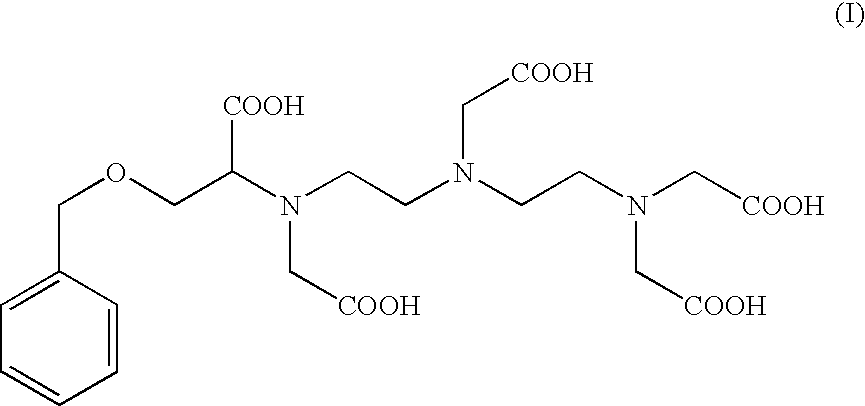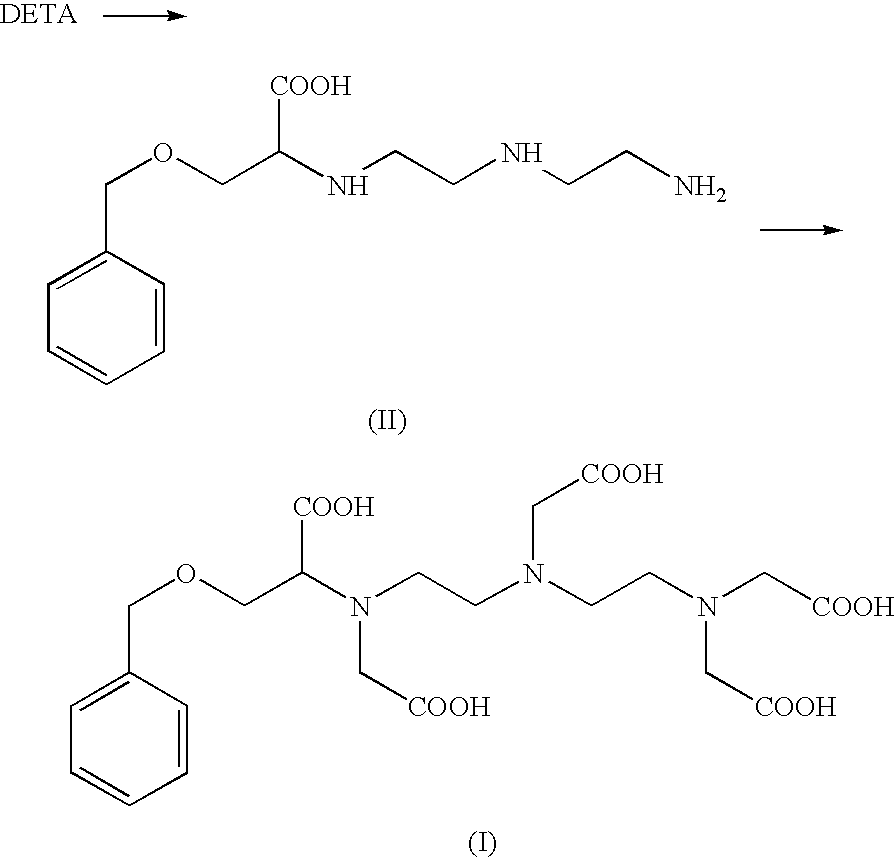Process for the preparation of contrast agents
a contrast agent and process technology, applied in the field of nuclear magnetic resonance technique, can solve the problems of remarkable drawback and limitation, inaccurate electrode ph measurement, and marked decrease in process yield and degree of purity of the final compound, and achieves low or potentially lower performance upon use, high yield, and high purity degree
- Summary
- Abstract
- Description
- Claims
- Application Information
AI Technical Summary
Benefits of technology
Problems solved by technology
Method used
Image
Examples
example 1
Preparation of the Compound of Formula (I): 4-carboxy-5,8,11-tris(carboxymethyl)-1-phenyl-2-oxa-5,8,11-triazamidecan-13-oic Acid (I).
example 2
Preparation of 4-carboxy-5,8,11-tris(carboxymethyl)-1-phenyl-2-oxa-5,8,11-triazamidecan-13-oic Acid (I) According to Alternate Sequential Additions of the Reactants
[0100]Step (a) In a vessel of 3 L, 417 g of an aqueous solution of the carboxylate sodium salt of (II) (40% w / w as trihydrochloride and corresponding to 0.43 mol), kept at room temperature (20°-25° C.), was reacted with 74 g (0.43 mol) of an 80% bromoacetic acid aqueous solution, which was added in 15 minutes. At the end of the addition, 114 g of a 30% aqueous solution of sodium hydroxide (0.85 mol, solution at 30%) was added in 15 minutes, maintaining this same temperature of 20-25° C.
[0101]Then, three additional aliquots of an 80% bromoacetic acid solution (74 g each aliquot) and three additional aliquots of a 30% sodium hydroxide solution (114 g each aliquot) were consecutively added, in an alternated way, to the reaction mixture. Each addition was carried out in 15 minutes.
[0102]Step (b) Then, at the end of step (a), ...
example 3
Preparation of the Compound of Formula (I) Through Different Embodiments of the Process
[0107]The compound of formula (I) was prepared according to the present process, by properly varying some of the operative conditions being reported in example 2 such as: temperature, sequence of addition of the aliquots of reactants, amount of the reactant themselves and time of addition.
[0108]Trials from 1 to 2 and 4 to 6 were performed by using 417 g of an aqueous solution of the carboxylate sodium salt of (II) (40% w / w as trihydrochloride and corresponding to 0.43 mol). Trial 3 was carried out by using and aqueous solution of the carboxylate sodium salt of (II) at 34% w / w, calculated as trihydrochloride salt, and corresponding to 0.43 mol.
[0109]In all of the trials there were added aliquots of an 80% w / w bromoacetic acid solution and a 30% w / w sodium hydroxide solution. Results are reported in the following table I
[0110]In every trial:[0111]A corresponds to an 80% bromoacetic acid solution (74...
PUM
| Property | Measurement | Unit |
|---|---|---|
| temperature | aaaaa | aaaaa |
| temperature | aaaaa | aaaaa |
| temperature | aaaaa | aaaaa |
Abstract
Description
Claims
Application Information
 Login to View More
Login to View More - R&D
- Intellectual Property
- Life Sciences
- Materials
- Tech Scout
- Unparalleled Data Quality
- Higher Quality Content
- 60% Fewer Hallucinations
Browse by: Latest US Patents, China's latest patents, Technical Efficacy Thesaurus, Application Domain, Technology Topic, Popular Technical Reports.
© 2025 PatSnap. All rights reserved.Legal|Privacy policy|Modern Slavery Act Transparency Statement|Sitemap|About US| Contact US: help@patsnap.com



